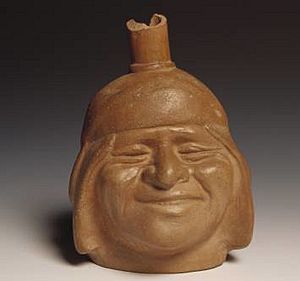Huaco (pottery) facts for kids
A huaco (pronounced WAH-koh) is a special type of pottery made by ancient people in Peru. These beautiful pots were created by indigenous peoples before Christopher Columbus arrived in the Americas. You can find huacos in old places like burial sites, temples, and other ancient ruins.
Huacos are not just everyday pots. They are important artworks used for ceremonies, religious events, or simply for their beauty. Many different cultures in the central Andes mountains made huacos. The Wari, Nazca, and Moche people were famous for their amazing ceramic skills. Even the Incas, who took over many cultures, also made huacos.
Contents
What Does "Huaco" Mean?
The word "huaco" likely comes from the Quechua word "huaca" (or waqa). A "huaca" is a sacred or special place, like an ancient temple or burial site. Since these pottery pieces were often found in such places, they became known as huacos.
Sometimes, you might hear the word huaquero. This is a person who digs in ancient ruins to find valuable artworks. Sadly, huaqueros often damage these old sites while looking for pieces. This can destroy important clues about the past.
Different Styles and Colors of Huacos
Huacos come in many shapes, styles, and colors, depending on the culture that made them.
- Some cultures, like the Moche, often used only two colors, like black and dull red. Their pottery often shows detailed painted scenes that tell a story.
- Other cultures used many bright colors, creating very colorful designs.
- Many huacos have special "bridge handles" that connect two spouts or parts of the pot.
These ceramic pieces often show amazing details. Some huacos are like sculptures, showing:
- Complex shapes and designs.
- Scenes from daily life or cultural events.
- Buildings.
- Realistic human faces, like the famous Moche Portrait Ceramics.
- Body parts, possibly as offerings.
- Tools, fruits, foods, or animals.
Huacos were usually not made for everyday use, like holding water or food. They were special items, often larger or more detailed than regular pots. For example, the tall, slender Inca pots called aryballos were used for carrying liquids. Even fancy ones are not usually called huacos because their main purpose was practical.
Where to See Huacos Today
If you want to see many huacos, you can visit museums in Peru.
- The National Museum of the Archaeology, Anthropology, and History of Peru in Lima has a huge collection of ancient pottery.
- The nearby Larco Museum is also famous for its large collection of Moche ceramics, including many portrait vessels.
|
See also
 In Spanish: Huaco para niños
In Spanish: Huaco para niños



